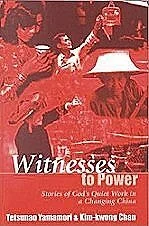Note: This book review was originally posted here on October 4, 2009.
Yamamori, Tetsunao, & Chan, Kim Kwong. Witnesses to Power: Stories of God’s Quiet Work in a Changing China. London, England, and Waynesboro, Georgia: Paternoster Press, an imprint of Authentic Media. 2000, reprinted in 2006. Paper. 109 pages, including appendices. ISBN 1-8422-041-9.
Despite its brevity, Witnesses to Power contains a wealth of information. As Ralph Covell observes in the Foreward, this slim volume is marked by breadth, diversity, balance, and challenge. These stories come from one end of China to the other. They speak of rural and urban evangelism, healing and exorcism, compassionate care for needy children, community life of the Jesus family, church planting and growth in remote areas not penetrated by outside Christian witness, and the impact of the gospel to produce economic prosperity.
Balance is observed also by inclusion of testimonies from both Three-Self Patriotic Movement (TSPM) and unregistered churches.
He concludes, as the authors do, that “the best way for outside groups to be involved in China will be in the use of ‘unconventional mission methods’. These will include holistic ministries helping churches both to evangelize and to seek the economic well-being of Christians and the societies, both Han and minority, in which they live.”
The remarkable growth of the church in China has been, to some degree, “silent”: It has come about mostly because of “the living faith of many ordinary Chinese Christians,” who are “unknown, ordinary people, with extraordinary stories to tell.” Witnesses to Power contains twelve such stories, from a wide range of people.
This gallery of Christian heroes includes a highly-educated Christian who migrated to western China to share the Gospel with Muslims; an old grandmother in Hebei who single-handedly started and led a church during the hard years of communist persecution; a Lisu pastor who ministers not only to his own tribe but also to other ethnic groups in areas inaccessible by vehicular travel; a lone Christian who established an entire school system for poor children.
We are introduced also to the serene faith of Christians who lost their homes and church building in a fire that destroyed the whole village; the promotion of Christianity by local governments in their efforts to eradicate opium addiction and poverty; and the holistic ministry of the Lisu church.
The book’s wide sweep takes in the Jesus Family, whose vibrant and harmonious community life inspires local communist officials; a pastor whose congregation lives and meets in large caves; and a woman whose faith was kindled during the Boxer rebellion, waned in her middle years, and revived when she called out to God in distress.
A full and meaty Introduction is supplemented by concise introductions to each chapter. Academic study, time in China, and extensive interviews give the two authors a breadth and depth of insight that place the testimonies into their wider context.
They remind us, for example, that the TSPM is “not a monolithic entity, but a loose fellowship with diverse views.” Some house churches have developed into large networks, ‘autonomous Christian communities’ (ACC), with training and extensive publications. Overseas Chinese Christians contribute to church growth by bringing in literature, providing training, radio broadcasts.
The much-heralded rapid economic growth since the 1980s has been matched by “overpopulation, low productivity, and serious weaknesses in infrastructure. Most are suffering from high inflation and loss of security.” Resentment at government corruption runs deep and wide. Churches face government control and restriction, while local corruption leads to more harassment in many areas.
The particulars of personal testimony and local examples provide evidence for the authors’ isolation of eleven factors, aside from the work of the Holy Spirit, that have led to growth, outlined on pages xiv-xvi. Briefly:
Christianity (1) is seen as, in some sense, an improvement on traditional Chinese beliefs; (2) has a highly flexible and successful organizational form; (3) benefited in the 1980s and 1990s from the prestige of the West.
(4) Many believers were brought up in families or communities that had been Christian for a long time.
(5) A key strength of Protestantism has been its evangelistic nature; (6) it offers attractive forms of worship; and (7) self-respect and enhanced personal identity, especially for (8) young people and women.
(9) Evangelism gives young believers “a sense of mission in life.” Christianity provides (10) hope for the future with its strong “eschatological tone”; and (11) is less expensive to observe than are traditional faiths and customs!
In addition, growth of rural churches may be partly attributed to disillusioned Red Guards who had been sent down to the country; believers who suffered in labor camps; Overseas Chinese with Bibles and other literature, and radio.
Above all, however, throughout this book we see an emphasis upon radical discipleship, a willingness to give up all to follow Christ, that shames comfortable believers in the West and exemplifies both the core of this book and the chief lesson which we can learn from our brothers and sisters in China.
